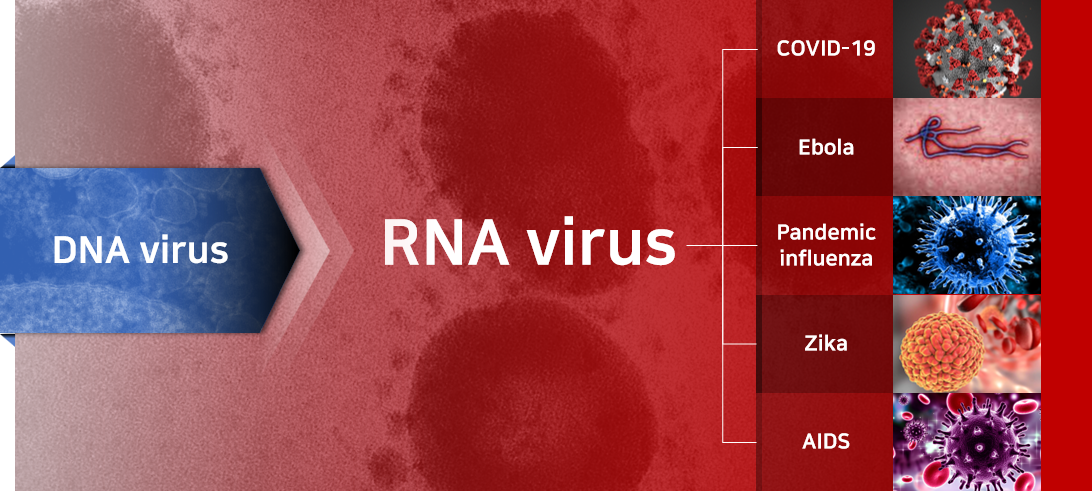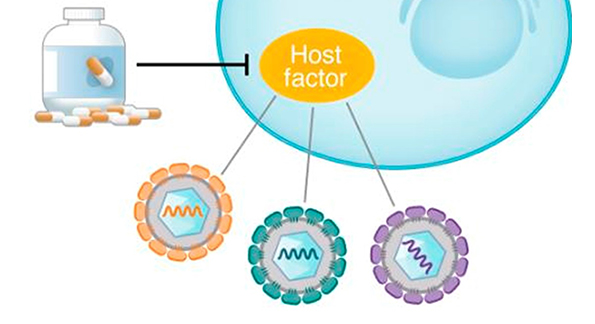Virus Threat
Virus Threat
- The reason we are trying to develop antiviral drugs is because viruses are one of the leading causes of the greatest loss of life in human history.
- In the case of COVID-19, which broke out in Wuhan, China in December 2019, 7 million to 35 million people have died so far.
- Even during World War I, up to 100 million people died from the Spanish flu.
Viral Diseases? The Most Fearsome Enemy of Mankind!


Virus Threat-continued
- In particular, the viruses that are causing the most damage to humanity in the 20th and 21st centuries include COVID-19, Ebola, influenza, Zika, and AIDS.
- Surprisingly, all of these are RNA viruses.
A Recent Major Disaster Viral Diseases!

- RNA viruses are problematic because mutations occur more frequently than DNA viruses.
The Problem of RNA Viruses!

-
RNA virus
In one replication
- 10,000 to 100,000 viral genome nucleic acids
- 1 mutation occurred
-
DNA virus
In one replication
- 1 million to 100 million viral genome nucleic acids
- 1 mutation occurred
-
Human protein (genes)
Mutations rarely occur
- Now, let’s look at the problems related to RNA viruses and commercially available antiviral drugs.
- Most antiviral drugs currently on the market target viral proteins.
- The problem, as mentioned earlier, is that RNA viruses undergo frequent mutations.
- This causes the viral protein, which is the target of commercially available antiviral drugs, to mutate.
- Accordingly, virus-targeting antiviral drugs currently on the market have reduced or lost efficacy against mutant strains.
The Problems Related to RNA Viruses and Commercially Available Antiviral Drugs!
Commercially available antiviral drugs?
Mostly Viral protein-targeting drugs

Problem
- RNA virus
- Frequent occurrence of mutation
- Mutation of viral protein targeted by commercially available antiviral drugs
- Reduction or loss of efficacy of commercially available antiviral drugs
- Host-directed antiviral drugs can solve all of these problems of virus-targeting antivirals at once.
A Solution Found!
Virus-targeted antiviral drugs

Frame shift
Host-directed antiviral drugs
- The basic concept of host-directed broad-spectrum antiviral drugs is as follows.
- All viruses can only multiply within host cells. When a virus proliferates, it must use various factors from the host. Currently, substances that control host factors essential for the virus life cycle can be developed as antiviral drugs.
- In particular, we are discovering host factors commonly used by various viruses. We can develop a new concept of innovative host-targeted broad-spectrum antiviral drugs to treat mutant strains and emerging new viruses.
- In conclusion, what our company is developing is a host-directed, broad-spectrum antiviral drug.
What Host-Directed Antiviral Drugs Are!
-

All viruses
Only replicate in the cells
-

Necessary of host factors
To replicate, host factors should be used
-

Point of drug action
Inhibitors of essential host protein to be used for viral replication ▷ Drug candidates

Discovery of host factors commonly used by various viruses

Development of substances for inhibiting common host factor
"Could be developed as an innovative host-directed broad-spectrum antiviral drug that can treat mutant strains and newly emerging viruses"
- Our host-directed broad-spectrum antiviral drugs have unique differentiation compared to competitor products.
- In other words, competitor antiviral drugs are virus-targeting drugs, so their efficacy against mutant strains and new viruses is reduced or lost.
- However, what our company is developing has the distinction of maintaining efficacy even against mutant strains and new emerging viruses.
A Unique Difference!
Competitor’s Drugs

Virus protein-targeted antiviral drugs
Our Drugs
Host-directed broad-spectrum antiviral drugs

-
Efficacy
Mutants Emerging
